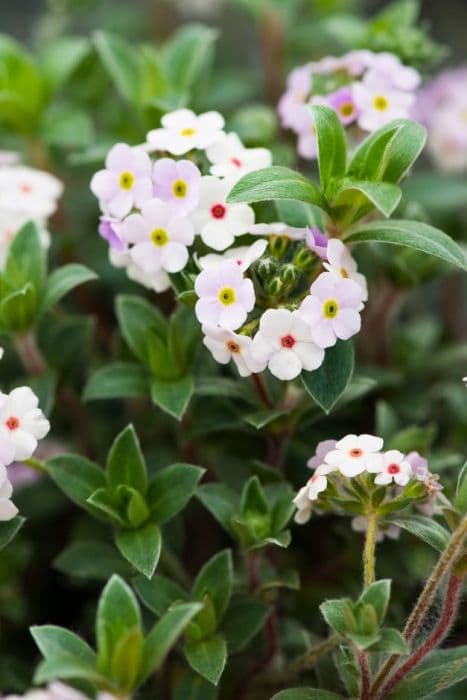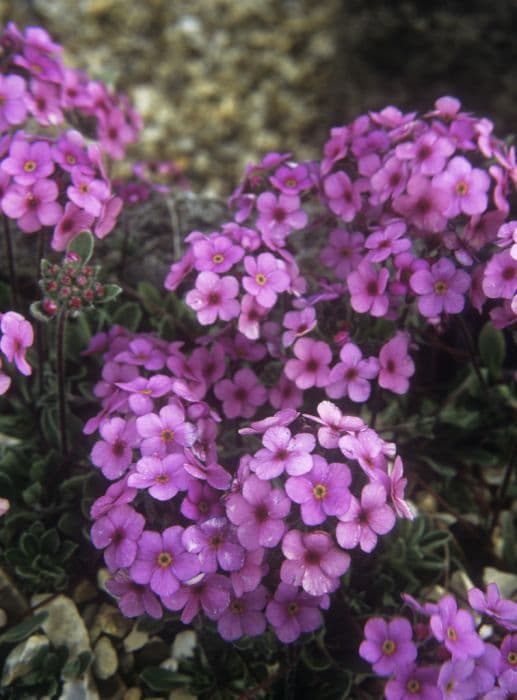Persian violet Cyclamen 'Laser White'

ABOUT
Cyclamen 'Laser White' is a striking plant known for its distinct blooms and attractive foliage. The flowers are an eye-catching, brilliant white that stand out with their upswept petals, which are elegantly reflexed at the edges, giving them an appearance reminiscent of a wing or a butterfly in flight. Each flower emerges on a slender stem, gracefully arching above the foliage. The leaves of the plant are equally beautiful, with a distinctive heart shape and a deep green color, often patterned with intricate silver or grey marbling, which adds to the visual interest of the plant. The foliage forms a compact, basal rosette that acts as a lush backdrop for the bright white flowers. Although not detailed in size, the overall impression of Cyclamen 'Laser White' is one of neatness and delicate charm, with the stunning white blossoms creating a vivid contrast against the patterned foliage, making it a popular choice among gardeners and indoor plant enthusiasts alike for its decorative appeal.
About this plant
 Names
NamesFamily
Primulaceae.
Synonyms
Persian Violet, Sowbread.
Common names
Cyclamen persicum 'Laser White'.
 Toxicity
ToxicityTo humans
Cyclamen is a plant that can be toxic to humans if ingested. The most poisonous part of the plant is the tuber, which contains saponins that can cause symptoms if consumed. The symptoms of cyclamen poisoning can include nausea, vomiting, and diarrhea. In severe cases, ingestion can lead to heart rhythm disturbances, seizures, and even death, although such extreme reactions are rare.
To pets
Cyclamen is also toxic to pets, including cats and dogs. The tubers of the plant contain the highest concentration of toxic compounds. If a pet ingests any part of a cyclamen plant, possible symptoms can include vomiting, diarrhea, salivation, and loss of appetite. In severe cases, ingestion can lead to heart rhythm abnormalities, seizures, and potentially death if not treated promptly. It is important for pet owners to keep cyclamen plants out of reach of their animals to avoid accidental ingestion.
 Characteristics
CharacteristicsLife cycle
Perennials
Foliage type
Evergreen
Color of leaves
Variegated
Flower color
White
Height
6 inches (15 cm)
Spread
6 inches (15 cm)
Plant type
Bulb
Hardiness zones
5
Native area
Mediterranean
Benefits
 General Benefits
General Benefits- Ornamental Appeal: With its beautiful white flowers and attractive foliage, Cyclamen 'Laser White' provides aesthetic enhancement to gardens and indoor spaces.
- Compact Growth: It is suitable for smaller areas or pots due to its manageable size.
- Seasonal Interest: It typically blooms in the fall and winter, offering color and interest during the colder months when other plants may not be flowering.
- Drought Tolerance: Once established, it can be relatively drought-tolerant, requiring less watering compared to many other plants.
- Easy Care: Cyclamen 'Laser White' is known for being easy to care for, making it suitable for beginner gardeners.
- Long Blooming Period: It often has a prolonged blooming period, providing flowers for several weeks or even months under the right conditions.
 Medical Properties
Medical PropertiesThis plant is not used for medical purposes.
 Air-purifying Qualities
Air-purifying QualitiesThis plant is not specifically known for air purifying qualities.
 Other Uses
Other Uses- Cyclamen 'Laser White' can be used as a natural insect repellent when planted around the garden or outdoor seating areas due to its fragrance that some pests find unappealing.
- The flowers of the Cyclamen are sometimes used in the craft of flower pressing, where their distinct shape and color can be preserved and displayed in art projects.
- The tubers of Cyclamen plants can be sliced, dried, and strung into a decorative garland for festive occasions, adding a unique floral touch.
- During the dormant period in summer, the dried tubers can be used as a creative addition to fairy gardens or miniature landscapes as they resemble small boulders or other natural elements.
- Cyclamen's attractive foliage can be a backdrop in photography, especially in macro photography to create whimsical scenes or emphasize the delicate nature of smaller subjects.
- The reflective qualities of 'Laser White' Cyclamen flowers can be cleverly positioned in moon gardens designed to glow under the light of the moon for nighttime aesthetic.
- Edible varieties of Cyclamen tubers can be processed and used as a food starch, although 'Laser White' is not typically known for this use and caution should always be taken.
- The distinctive foliage and flowers of the Cyclamen can be used as natural dye sources for textiles, though results and practices will vary and may require experimentation.
- Cyclamen plants can provide educational opportunities for children and adults alike to learn about botany, particularly bulb growth and dormancy cycles.
- Cyclamens can be used in botanical artistry, helping artists to study and recreate realistic representations of the plant's unique flower and leaf shapes.
Interesting Facts
 Feng Shui
Feng ShuiCyclamen is not used in Feng Shui practice.
 Zodiac Sign Compitability
Zodiac Sign CompitabilityCyclamen is not used in astrology practice.
 Plant Symbolism
Plant Symbolism- Love and Devotion: Cyclamen, commonly referred to as Persian violet, often symbolizes sincere love and devotion, making it a perfect gift for a significant other.
- Resignation and Goodbye: In the language of flowers, giving someone cyclamen can imply a resignation or farewell, suggesting the end of a relationship.
- Deep Sentiments: The rich and vibrant colors of cyclamen blooms are associated with deep emotions, representing a feeling that comes from the heart.
- Maternal Love: In some cultures, cyclamens represent the undying love of a mother, likely due to their nurturing growth habits.
- Inner Strength: Cyclamen's ability to grow in colder climates signifies resilience and the capacity to overcome challenges.
 Water
WaterCyclamen prefers to be watered when the soil feels dry to the touch. Usually, it's best to water the plant once every 7-10 days, allowing the top inch of soil to dry out between waterings. It's important to water the cyclamen from the bottom to avoid wetting the crown and leaves, which can lead to fungal diseases. Place the pot in a tray filled with 1-2 inches of water and let the plant absorb moisture for about 15 minutes. If water is still in the tray after this time, discard it to avoid overwatering. Generally, a cyclamen will thrive when provided with about 8-12 ounces of water at each irrigation, but always adjust according to your specific indoor conditions.
 Light
LightCyclamen prefer bright, indirect sunlight and thrive in east or north-facing windows where they can receive some morning light without the harsh midday sun. Avoiding prolonged direct sunlight is crucial, as it can scorch the leaves of the cyclamen. An ideal spot would offer diffused light that mimics the plant's natural environment under the tree canopy in its Mediterranean habitat.
 Temperature
TemperatureCyclamen thrive in cool environments with temperatures between 60 and 70 degrees Fahrenheit during the day and not exceeding 50 degrees Fahrenheit at night. They prefer cooler temperatures and do not do well in heat above 68 degrees Fahrenheit. The plant's tubers may begin to deteriorate if exposed to prolonged temperatures over this range or to frost.
 Pruning
PruningPrune cyclamen to remove yellowing or dead leaves and spent blooms to encourage new growth and maintain a tidy appearance. Pruning is best done periodically throughout the flowering season. After the cyclamen completes its blooming cycle and enters dormancy, remove the old leaves to conserve the plant's energy for the next growing season.
 Cleaning
CleaningAs needed
 Soil
SoilCyclamen 'Laser White' thrives in well-draining, humus-rich potting mix with a slightly acidic to neutral pH of around 6.5-7.0. An ideal soil mixture could be equal parts of peat moss, perlite, and loam, ensuring good aeration and moisture retention without waterlogging the roots.
 Repotting
RepottingCyclamen or Persian violet generally needs repotting every couple of years or when it becomes pot-bound. It is best to repot these plants after they have finished flowering and have gone dormant, usually in late spring or early summer.
 Humidity & Misting
Humidity & MistingCyclamen 'Laser White' prefers a moderately humid environment, with ideal humidity levels ranging from 40-60%. Avoid placing the plant in excessively dry conditions, which can cause the leaves to wilt.
 Suitable locations
Suitable locationsIndoor
Keep in indirect light, well-draining soil, and moderate humidity.
Outdoor
Plant in dappled shade, sheltered, in well-drained soil.
Hardiness zone
5-9 USDA
 Life cycle
Life cycleCyclamen 'Laser White', commonly known as Sowbread, begins its life cycle with seed germination, which typically occurs in cool, dark environments. After germination, the seedlings develop into juvenile plants with heart-shaped leaves and a small corm, or bulb-like structure, which store energy for the plant's growth. As the plants mature, they enter a vegetative stage where the leaves fully expand and the corms increase in size. The flowering stage follows, where the plant produces its characteristic white flowers with upswept petals, usually during the cooler months. After pollination, the flowers will fade and seed pods develop, eventually releasing seeds to complete the reproductive cycle. During hot and dry summers, Cyclamen 'Laser White' enters a dormant period, with leaves dying back and the plant surviving off stored energy in the corm until cooler, moist conditions return and a new cycle begins.
 Propogation
PropogationPropogation time
Spring-Early Summer
Cyclamen 'Laser White', commonly known as Cyclamen, is primarily propagated through seed. The best time to sow Cyclamen seeds is in the late summer or early autumn. To propagate Cyclamen by seed, you should soak the seeds for 12 to 24 hours to soften the seed coat, which can enhance germination rates. Afterwards, sow the seeds on the surface of a well-draining seed starting mix, pressing them lightly into the medium, and maintain a temperature of around 60 to 68 degrees Fahrenheit (15 to 20 degrees Celsius). It can take several weeks to months for Cyclamen seeds to germinate, so patience is required. Once the seedlings develop their true leaves and are large enough to handle, they can be transplanted into individual pots.









